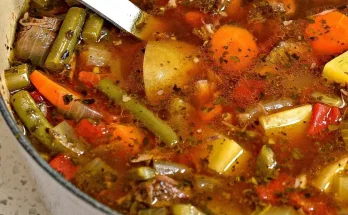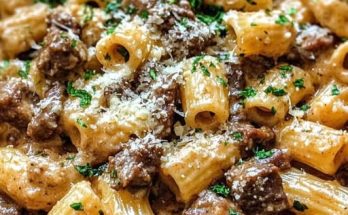Jump to Recipe Print Recipe
Using my perfected Master Scones Recipe, you can create your own delicious Recipe with a variety of add-ins such as chocolate chips, berries, or cheese and herbs.

These homemade treats are better than what you’d find at a bakery—flaky, flavorful, and moist with crisp, crumbly edges. There’s plenty of helpful information and step-by-step photos included, but you can skip ahead to the recipe if you prefer!
Scones, whether sweet or savory, are perfect companions for coffee and tea, making them a hit at baby showers, bridal showers, brunches, snack times, bake sales, Mother’s Day, and any occasion where muffins or coffee are enjoyed. (Which is pretty much always!)
However, scones can sometimes turn out dry and flavorless, with a texture resembling sandpaper and a taste reminiscent of cardboard. They can also spread too much and end up tasting bland. But bland isn’t in our scone vocabulary! My basic scone recipe guarantees uniquely crisp and buttery scones with crumbly edges and a soft, flaky interior.
I have several scone recipes that all start with the same basic formula. Let’s go over the fundamentals so you can learn how to make the best scones. Get comfortable, because there’s a lot to cover in this post!
Get updates on the latest Recipes and more from brightermeal straight to your inbox.SubscribeI consent to receiving emails and personalized ads.

Jump To
What are Master Scones?
Master Scones are a delightful baked good that often get compared to biscuits due to their similar texture and appearance. Originating from the United Kingdom, traditional scones are a staple in many tea-time gatherings. They are made from a simple dough consisting of flour, butter, sugar, and milk or cream, resulting in a slightly crisp exterior and a tender, flaky interior.
Master Scones can be sweet or savory and are incredibly versatile. For those with a sweet tooth, scone recipes can include delicious variations like Blueberry scones or pumpkin scones, which are perfect for seasonal treats. Sweet scones are often topped with vanilla icing for an extra touch of sweetness.
On the savory side, scones can include ingredients like cheese and herbs, making them a great addition to breakfast or brunch menus. No matter the flavor, scones are best enjoyed fresh from the oven, often paired with clotted cream and jam, and are a perfect complement to a cup of tea or coffee.
No matter which flavor you choose, these Master Scones are:
- Moist and soft on the inside
- Crumbly on the edges
- Buttery and flaky
- Never dry or gritty
Only 7 Ingredients in this Basic Master Scones Recipe
You only need 7-9 ingredients for my master scone recipe:
- Flour: Use 2 cups of all-purpose flour, plus extra for the work surface and your hands.
- Sugar: Typically, I use around 1/2 cup of sugar for the scone dough. You can reduce this amount, but keep in mind it will slightly alter the scone’s flavor and texture. For savory scones, reduce it to about 2 tablespoons. Brown sugar is also an option, but if you use it, whisk it into the wet ingredients to remove any lumps.
- Baking Powder: This ingredient provides lift.
- Salt: Adds essential flavor.
- Butter: Butter is crucial for scones, contributing to their flakiness, flavor, crisp edges, and rise.
- Heavy Cream or Buttermilk: For the best tasting scones, use a thick liquid like heavy cream or buttermilk. Heavy cream is my usual choice, but if you prefer a slightly tangy flavor, opt for buttermilk. Thinner liquids can lead to dry, bland, and flat scones.
- Egg: Adds flavor, lift, and structure to the scones.
- Optional: Vanilla extract is essential for sweet scones but can be omitted for savory ones. Depending on the flavor, cinnamon is another great addition.
- And don’t forget the add-ins! Scroll down to discover all my favorite scone flavors.
How to Make Scones from Scratch
Here’s how to make scones from scratch:
- Mix the dry ingredients together: Use a large mixing bowl to ensure there’s plenty of room for the mixing process.
- Cut in the grated frozen butter: You can use a pastry cutter, 2 forks, or your hands. Avoid using a food processor as it may overwork the dough, resulting in dense scones. Aim for a messy and crumbly texture.
- Whisk the wet ingredients together: In a separate bowl, whisk together the wet ingredients.
- Combine wet and dry ingredients: Mix the wet and dry ingredients together, then pour the mixture onto the counter.
- Form into a disc and cut into wedges: Shape the dough into a disc and cut it into wedges. Alternatively, you can make 10-12 drop scones.
- Brush with heavy cream or buttermilk: For a golden brown, extra crisp exterior, brush the scones with liquid before baking. You can also sprinkle coarse sugar for extra crunch.
- Refrigerate for at least 15 minutes: To prevent over-spreading, chill the shaped scones in the refrigerator for at least 15 minutes before baking. You can even refrigerate them overnight for a quick breakfast.
- Bake until golden brown: Bake the scones in a preheated oven at 20-25 minutes or until they are golden brown.
Get updates on the latest Recipes and more from brightermeal straight to your inbox.SubscribeI consent to receiving emails and personalized ads.
Cold Ingredients & Frozen Grated Butter
Keeping scone dough cold is crucial to prevent over-spreading. When scones spread too much in the oven, they lose their flaky, moist, and delightfully crumbly texture, essentially becoming ruined. To avoid this disaster, it’s essential to use cold ingredients such as cold heavy cream, egg, and butter.
However, the real secret to success lies in using frozen grated butter. Similar to making pie crust, incorporating cold butter into the dry ingredients creates crumbs. As the scones bake, these butter-flour crumbs melt, releasing steam and forming air pockets. These pockets contribute to a flaky center while maintaining crumbly and crisp edges. Refrigerated butter may start melting into the dough as you work with it, but frozen butter will remain intact until it hits the oven. Additionally, the finer the pieces of cold butter, the less the scones will spread, and the faster the butter will blend into the dry ingredients. Remember, it’s crucial not to overwork the scone dough.
3 Tricks for Perfect Scones
Here are the key takeaways from this post:
- Heavy Cream or Buttermilk: Opt for thicker milks like heavy cream or buttermilk to ensure your scones are fluffy and flavorful. Canned coconut milk is a great non-dairy alternative.
- Frozen Grated Butter: As mentioned earlier, using frozen grated butter helps create flaky scones with crisp edges.
- Refrigerate Before Baking: Cold dough is essential for successful scones. To prevent over-spreading, refrigerate the shaped scones for at least 15 minutes before baking.
Remember, to prevent flat scones, follow tips #2 and #3
Get updates on the latest Recipes and more from brightermeal straight to your inbox.SubscribeI consent to receiving emails and personalized ads.
How to Freeze Scones
I used to be hesitant about freezing scone dough. The concern was that the baking powder, once wet, would activate and cause the scones to rise less in the oven if left unbaked. However, the decrease in rise is so minimal that it’s hardly noticeable. In fact, you can shape the scone dough into wedges and refrigerate them overnight before baking without any issues.
Here are two ways you can freeze scones:
- Freeze Before Baking: Place the scone dough wedges on a plate or baking sheet and freeze for 1 hour. Once they are relatively frozen, you can transfer them to a freezer-friendly bag or container. When ready to bake, you can bake them directly from frozen, adding a few extra minutes to the bake time in the recipe provided. Alternatively, you can thaw them overnight in the refrigerator before baking.
- Freeze After Baking: Once the scones are baked and cooled, you can freeze them before adding any toppings such as icing or confectioners’ sugar. Store them in a freezer-friendly bag or container. To thaw, leave them out on the counter for a few hours or overnight in the refrigerator. You can also warm them in the microwave for 30 seconds or on a baking sheet in a 300°F (149°C) oven for 10 minutes.
Scone Flavors
- Eggless Butter Scones
- Scones
With the master recipe provided below as your base, feel free to get creative with your favorite add-ins such as white chocolate chips, toasted pecans, sweetened or unsweetened coconut, dried cranberries, peanut butter chips, and more. If you’re adding particularly moist ingredients like chopped peaches, make sure to blot them with a paper towel before mixing them into the dough. For an extra touch, top your scones with lemon curd, raspberry sauce, or any of the suggested toppings listed below. Most importantly, enjoy experimenting and discovering your favorite flavor combination!



